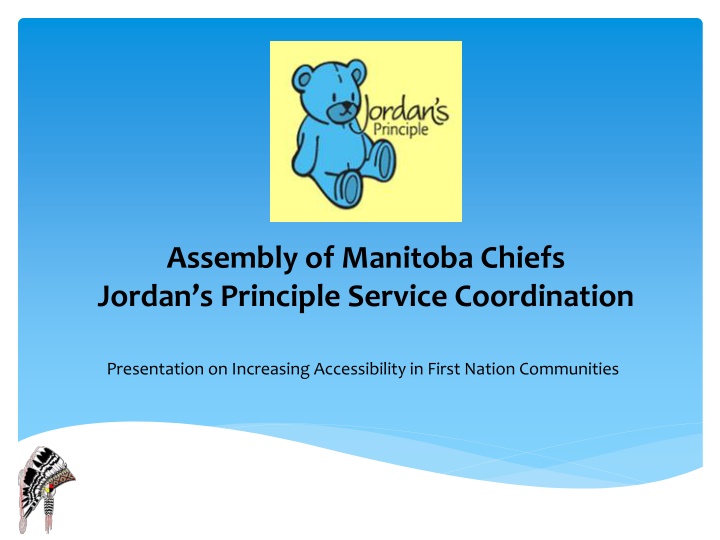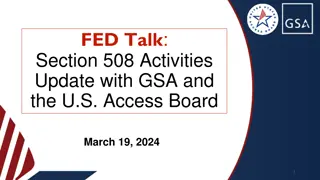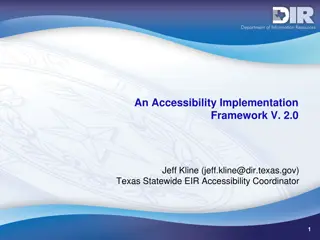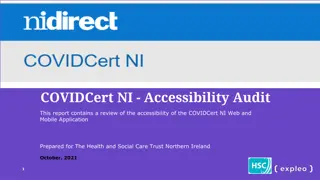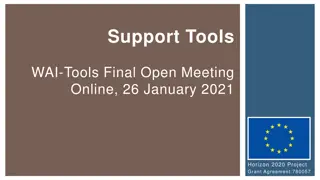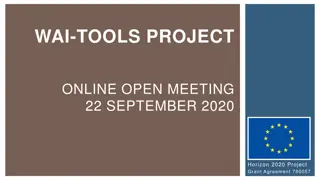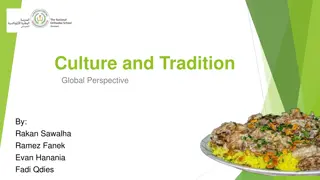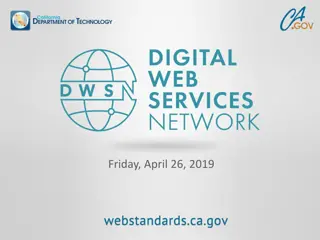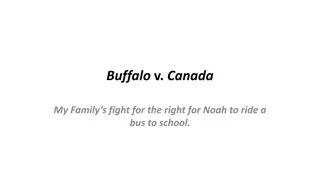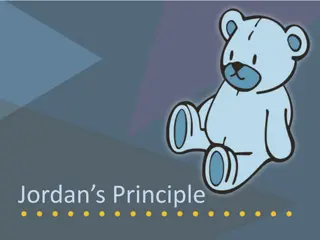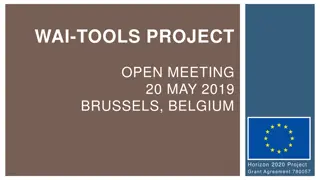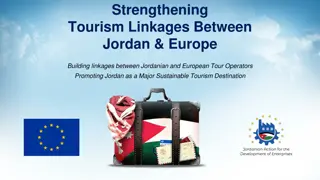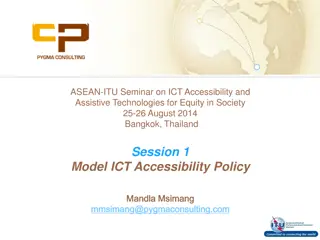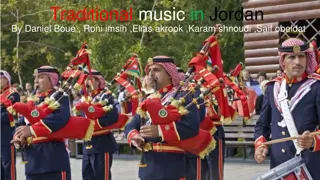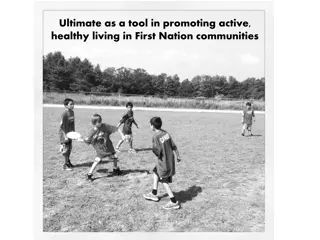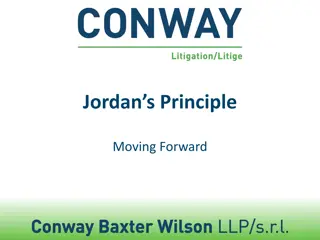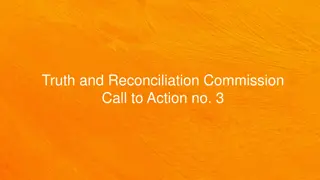Increasing Accessibility in First Nation Communities: Jordan's Principle Service Coordination
The Assembly of Manitoba Chiefs led an initiative to address discrimination against First Nations children and fully implement Jordan's Principle. The Keewaywin Engagement focused on creating a regional response to ensure access to essential services. The final report outlined recommendations for enhancing accessibility for individuals living with disabilities in First Nation communities. Emphasizing advocacy and education, the goal is to create inclusive environments and secure sustainable funding for support programs.
Download Presentation

Please find below an Image/Link to download the presentation.
The content on the website is provided AS IS for your information and personal use only. It may not be sold, licensed, or shared on other websites without obtaining consent from the author.If you encounter any issues during the download, it is possible that the publisher has removed the file from their server.
You are allowed to download the files provided on this website for personal or commercial use, subject to the condition that they are used lawfully. All files are the property of their respective owners.
The content on the website is provided AS IS for your information and personal use only. It may not be sold, licensed, or shared on other websites without obtaining consent from the author.
E N D
Presentation Transcript
Assembly of Manitoba Chiefs Jordan s Principle Service Coordination Presentation on Increasing Accessibility in First Nation Communities
BACKGROUND: JORDANS PRINCIPLE SERVICE COORDINATION WORK PLAN Keewaywin: Our Way Home, Manitoba First Nations Engagement is an Assembly of Manitoba Chiefs led initiative. It was designed to get First Nations input on the design and delivery of a regional response to the Canadian Human Rights Tribunal decision to stop discriminating against First Nations children that includes: Full implementation of Jordan s Principle; Reform the First Nations Child and Family Services (FNCFS) Program.
Keewaywin Engagement Manitoba First Nations Jordan s Principle Implementation Final Report Final Report identifies the information on how to fully implement Jordan s Principle in Manitoba. Reviewed and approved by the AMC Executive Council of Chiefs on September 13, 2017. It was shared with all Manitoba First Nations, and the First Nations who participated in the engagement will receive their individual PATH from the engagement sessions. Report was also provided to Health Canada (FNIHB) and INAC; which has now restructured as ISC.
Engagement Report recommendations Pertinent to Accessibility & Advocacy for First Nations Persons living with Disabilities on Reserve Education and training of First Nations citizens in fields of medicine and working with children with special needs. Creation of educational awareness campaign regarding challenges children with special needs face. Creation of Adult Day Program for First Nations children & youth and adults; separate from one another on reserve. Increasing accessibility in First Nations communities built environment s and public spaces. Conduct research on programs and service delivery in First Nations; examining existing laws and policies. Basic human rights provided to First Nations children and their families. Establish Jordan s Principle program, resource and medical center. Draft a federal Jordan s Principle Law and a framework for a Jordan s Principle Law for First Nations; ensuring secure sustainable funding. Continued advocacy for supports & program funding for First Nations adults living with disabilities as disabilities do not disappear once you are an adult.
Increasing Accessibility in First Nations Communities When Jordan s Principle reaches it full realization and service gaps no longer exist in First Nation communities; First Nation children, youth and their families who have previously had to leave their communities to access basic services will be able to relocate back to their First Nation to live among familiar faces, family and friends. The AMC wants to ensure First Nations Persons living with disabilities are able to live fully accessible and barrier free lives while remaining an integral part of their First Nation communities through participation and engagement. This can be achieved through advocacy for increased funding from the federal government with respect to operations and management to retrofit many of the aging existing infrastructure which at the time of their construction, were not built with accessible built environments in mind. This would be in addition to advocacy for increased infrastructure budgets to accommodate the growing requirements of First Nation communities to accommodate fully accessible built environments.
Increasing Accessibility in First Nations Communities The Assembly of Manitoba Chiefs has been working with the Manitoba League of Persons with Disabilities and the Manitoba First Nations Education Resource Centre Communications and Publications Department on this initiative. Proposed environmental accessibility scans will involve shooting video footage in our First Nation Pilot Community of what is involved in an environmental accessibility scan and include instruction on how to facilitate environmental accessibility scans in each of the three phases described below. Video footage will be edited and published by the Manitoba First Nations Education Resource Centre with consultation provided by the Manitoba League of Persons with Disabilities. Additional resources pertaining to First Nations Persons living with Disabilities will also be included in the final DVD product which will be distributed as a resource to all Manitoba First Nations communities. This project is a multi-year and will be broken down in three parts. The first phase will involve environmental accessibility scans of First Nations Schools. The rationale for deciding schools in the first phase was ideal as children and youth spend the majority of their times outside of their homes in education spaces during the school year. The second phase will involve environmental accessibility scans of First Nations primary public use buildings. These include but are not limited to administration offices, community halls, health centers and public parks and beaches. The third phase will involve environmental accessibility scans of First Nations private enterprises. These include First Nations local stores, financial institutions, restaurants and entertainment centers.
What is Accessibility? Accessibility for First Nations Persons living with disabilities does not merely refer to domestic spaces. In many cases, First Nations Persons living with disabilities, especially those with mobility impairments, often find themselves trapped inside their homes due to inaccessible built environments, transportation and public spaces. Frequently, this is because the spaces external to their homes do not cater to their mobility requirements. The causes of their struggles range from cracked and often no paved roads and walkways; obstacle-ridden thoroughfares, the absence of ramps for wheelchair users, to inaccessible transport. These barriers exclude people with impairments from the integral social fabric of First Nation communities. Furthermore, these physical barriers in public places effectively reinforce the negative social view that First Nations Persons living with disabilities are a minority and a burden on their families.
Accessibility issues can take many forms in First Nations; for example: Derek had long been interested in doing some sort of volunteer work, and when he heard that an organization external to his First Nation community was bringing in a speaker to present on Increasing volunteerism in First Nation communities, he was really excited about going. But when he went to the presentation, no sign language interpreter was present. Annoyed that such a large event didn't make it possible for him to enjoy the presentation, Derek left before applications and brochures on volunteering were handed out. Sage wanted her son Jordan to get involved with their local First Nations afterschool tutoring program. Transportation was provided for students in the program, but none of the buses used to take students to and from the tutoring site were wheelchair-accessible. While Jordan really could have used the help in his math classes, he was unable to participate in the program. When John Paul's wife died, he started attending a local support group for people who had lost loved ones. The support group facilitator always gave out lots of articles and other clippings that the other support group members said were very helpful, but John Paul was unable to use them because he had a visual impairment, and the facilitator never made any copies available in large type. Discouraged, he stopped attending the support group.
How do we increase Accessibility in First Nation communities? Increasing access means creating an environment that can be used by all people, including those who have disabilities. When we talk about accessibility, people often assume we mean making a building or other space accessible to wheelchair use and don't think beyond that. True accessibility, however, means giving thought to many different types of disabilities and how you can change things within your organization or initiative to make the people who have them feel welcome--not just the physical structure of your office or meeting spaces, but the attitudes and communication styles of people within your organization or initiative. So when we talk about increasing access, we mean doing it by: Changing attitudes within our First Nation or First Nation Organizations; Changing the way we communicate with others, and Changing physical things, such as the structure of the spaces we use and the formats in which we present information.
Why should you make your First Nation more accessible? The most apparent answer to this is that making your First Nation or First Nation organizations more accessible is simply the right thing to do. Making increased accessibility a priority in your First Nation or First Nation organizations also makes for a larger pool of potential volunteers, members, and staff. Providing access for people with disabilities is another way you can increase diversity in your First Nation or First Nation organizations. Additionally, it makes it possible for more people to make use of any services or programs you provide.
When should you make your First Nation or First Nation Organizations more Accessible? Any time is a good time to work on increasing access, but there are some times that you might not have thought about including accessibility issues in your plans but should: When you are looking to increase your numbers--whether that means people your organization or initiative serves or people who are involved as volunteers, members, or staff. When you are thinking about new spaces - for example, moving to a new office building or finding a new place to hold a weekly public meeting. When you're planning a conference, retreat, or some other special gathering. Sometimes people make the argument that making changes to increase accessibility is impractical, because they've been operating for years with few or no people with disabilities as part of their organization or initiative. Just because you haven't ever had a lot of people with disabilities involved in your organization or initiative right now doesn't mean that it's not a good time for improving accessibility.
How do you go about increasing accessibility? 1/2 The first step is to change the way you and others involved in your organization view people with disabilities. Of course, this is easier said than done, but there are things you can do to learn more about disability issues, how people with disabilities would like to be treated, and the basics of disability etiquette. One way to start is to reach out to people with disabilities and simply ask for their help in improving accessibility. Are there any people with disabilities already involved in your organization? Is there at least one person with a disability on your board of directors or advisory council? Ask those people for their input and assistance in bringing about change at your organization; they might want to form a task force or committee on accessibility and accommodation issues. Of course, people with disabilities who are asked to take these types of roles should not just be chosen as tokens or "window dressing", but should really be viewed and treated as equal partners in your organization or initiative.
How do you go about increasing accessibility? 2/2 Another step might be to do some staff training on disability issues. For this, you might want to bring in an outside consultant with expertise in this area. Additionally, getting staff and stakeholders familiar with disability etiquette could be a helpful start. Disability etiquette is a concept based simply on treating people with disabilities with courtesy and respect. With respect to disability etiquette, here are some things to keep in mind: Treat adults like adults, and treat people with disabilities like you would treat anyone else. Don't make assumptions about people with disabilities. If you have a question about what to do, just ask. People with disabilities will generally appreciate your honesty and would rather have you ask about their needs and wishes instead of making assumptions. Understand that two people with the same disability may have very different access needs. People with disabilities should be viewed as individuals, and their needs should be addressed accordingly. Not all disabilities are immediately apparent. "Hidden" disabilities such as hearing impairment or a chronic medical condition like diabetes -- may cause a person to not respond when you speak to him or her, or act in a way that may seem odd or inappropriate. Again, don't make assumptions. If someone behaves in a way that seems unusual at first, wait to find out more.
Change the way you communicate with regard to disabilities The language we use when talking about or with people with disabilities is closely tied to disability etiquette. When communicating consider: Use "people first" language. This means referring to the person first before referring to the disability: "a woman who is deaf" rather than "a deaf woman". The emphasis should be on the fact that this is a person and his or her disability is one of many things about him or her; a person's disability does not define him or her as a human being. Don't point out disabilities, but don't ignore them either. If someone's disability isn't pertinent to the conversation, don't discuss it unless the person with the disability brings it up. If it is relevant, though, it isn't impolite to bring it up. Hesitating to address a person's disability can imply that the disability is something wrong or bad--that it's an uncomfortable or unpleasant topic. It shouldn't be. A disability is something that person has and deals with every day, and it's fine to acknowledge that. Many words associated with disabilities in the past are now recognized as loaded and biased and should no longer be used because of their negative connotations. Avoid referring to people with disabilities as "crippled" or as a "victim" of his or her disability, saying someone "suffers from" his or her disability (say he or she "lives with" it instead), and referring to nondisabled folks as "normal." Find out how the person with a disability communicates best. For example, while many people who are blind can use Braille, the majority of people who are blind do not. By the same token, not all deaf people can lip-read, and even when they do, it is only 30% to 50% effective, because so many words look similar. When in doubt, just ask, "What way is best for us to talk with each other?"
Changing the built environment of the spaces we use in First Nation Communities Changing attitudes and language are very important, but if people with disabilities can't actually make it into your building or meeting spaces or use your services, those things aren't very meaningful. If you are in the process of building a new facility or making changes to an existing structure, consider using Universal Design. Universal Design is a method of designing buildings, rooms, and other spaces with the following principles in mind: Equitable use: The design is useful and marketable to any group of users. Flexibility in use: The design accommodates a wide range of individual preferences and abilities. Simple and intuitive use: Use of the design is easy to understand. Perceptible information: The design communicates necessary information effectively to the user. Tolerance for error: The design minimizes hazards and the adverse consequences of accidental or unintentional actions. Low physical effort: The design can be used efficiently and comfortably. Size and space for approach and use: Appropriate size and space is provided for approach and use.
Changing the way we make community events more accessible in First Nations Before any meeting or event, be sure that any announcements, invitations, or advertisements include a statement about what sort of accessibility arrangements have been made (i.e., whether the site is wheelchair accessible, whether any alternative formats of written or spoken information will be available, etc.). Announcements should also include any information about accessible parking or accessible public transportation. More suggestions on what to include in your meeting or event notices will be made available on the next slide. A contact person should be designated and included on any announcements for questions or information regarding accommodations. If you have a registration form for your event, be sure the form includes a space for persons with disabilities to make their needs known
Basic Logistics for making community events more accessible in First Nations Print materials to be used at the event/meeting should be available in advance, on request. Seating space should be set up with intermittent seating for wheelchair users (remove chairs so that space is available for wheelchairs to fit in). Aisles and hallways should be wide enough for two people using wheelchairs to pass one another. When doors that are difficult to open can't be adjusted or propped open for the duration of the event, assistance should be provided at the door during the event. Films and slide shows should be captioned, whenever possible. Microphones, speaker's table, podium, stage areas, and the paths to those places should be accessible. If you will be presenting any information in alternative formats (see below), be sure you've planned far enough in advance to have these materials ready. If sign language interpreters will be used, they should be provided an advance copy of the materials presented at the event/meeting, whenever possible. Many hotels, convention sites and event areas have sound enhancement systems available for your use. Check with them. Also review with them the physical accessibility and event logistics checklists. On the day of the event, be sure that any temporary access arrangements, such as portable wheelchair ramps, have been put in place.
Alternative formats for information Many people with disabilities need to receive information in alternative formats. The following are a few of those formats and how you can accommodate people who need them. Sign language interpreterstranslate spoken words or audio into sign language. They can be found in the phone book under "Translation Services"; you may have to check in the nearest large city. They usually charge about $25 to $40 per hour with a two hour minimum, but some will donate services to nonprofit organizations. Audiotapesof meetings and printed materials should be available for people with visual impairments or people whose disabilities prevent them from easily taking notes. Many meeting facilities provide taping services, or you might wish to hire a professional taping service. Large printversions of printed materials should also be available. In this format, print is enlarged for persons with visual disabilities and persons with learning disabilities. On a computer, a font size of 18 to 24 point will produce large print. For directional signs and door markings, raised letters and numbers 5/8" high or larger should be used. Materials should be formatted so that people with disabilities can read them easily. Use narrow text columns with ragged right margins. Simplifying the formatting to include as little centering or columns as possible is also helpful. Double or triple space between lines to make it more readable, and use black lettering on off-white or pale yellow matte paper (colored paper or shiny papers can be harder to read).
Alternative formats for information Many people with disabilities need to receive information in alternative formats. The following are a few of those formats and how you can accommodate people who need them. Braille versions might also be made available. Braille is used for people who are blind; it translates printed letters into raised dots, which can be read by fingertips. To find a Braille transcription service, check with local organizations such as the Society for Manitobans with Disabilities or the Manitoba League for Persons with Disabilities to ensure accessibility for Persons living with blindness or visually impairment. Assistive listening devices are devices that make sound louder. They're slightly different from hearing aids in that hearing aids usually amplify all the sound in a particular environment, where assistive listening devices usually amplify a specific, desired sound (a lecturer's voice, for instance). Captioningprovides written text on the lower portion of the screen of films, videotapes, slides and public service announcements, and any other audiovisual programming, or on a screen for people attending events. There are three types of captioning styles generally used. Realtime captioning is provided mainly for programs that are live, where there is little or no advance information provided on what will be said. Open captioning places the text at the bottom of the screen, at all times, often in a black reader box. Subtitling differs from open captioning in that it allows for the printed text to be placed anywhere on the screen in a variety of print fonts and colors.
In summary More and more, people with disabilities are being recognized, understood, and valued. People with disabilities are not only as a population your organization should strive to serve, but also a valuable pool of potential staff, volunteers, and contributors. For any First Nations or First Nation organizations who are looking to increase accessibility for people with disabilities, we hope that this presentation has given you a good start as well as some ideas for where you can go for further assistance. For questions or comments related to the presentation please contact: Marcel Balfour Senior Policy Analyst Assembly of Manitoba Chiefs mbalfour@manitobachiefs.com (204) 957-4114 Jaron Hart Policy Analyst Assembly of Manitoba Chiefs jhart@manitobachiefs.com (204) 987-8456
